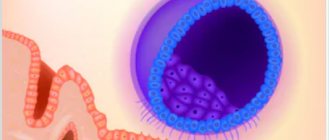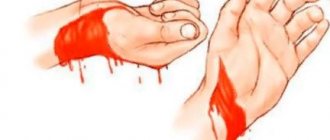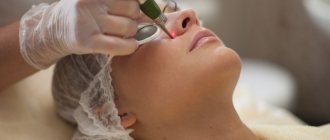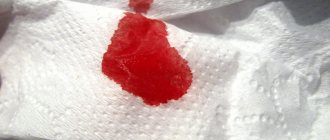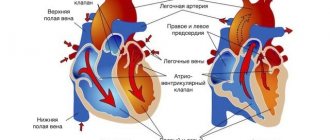Main manifestations of wounds
Pain
In this case, pain occurs due to damage to the nerve endings that were located at the site of the injury. Over time, swelling may increase, which also leads to increased pain. The severity and degree of manifestation of pain depends on factors such as:
- location of the defect, concomitant damage to large nerve trunks;
- type of weapon or conditions of damage (asphalt, garden, bicycle, sharp object, etc.);
- psychological state of the child.
In essence, pain is an adaptive defense reaction of the body.
Bleeding
Any damage to the skin or mucous membranes is in one way or another accompanied by damage to blood vessels (capillaries, arteries, veins). The nature and degree of bleeding depends on the type of damaged vessel. The larger the vessel and the higher the pressure in it, the more massive the bleeding, and vice versa. It is worth highlighting those places on the body that are accompanied by more heavy bleeding: face, head, neck, hands . In these places, the tissues are better supplied with blood. The condition of the blood coagulation system plays an important role. If a child has a minor abrasion or scratch, which is accompanied by prolonged and heavy bleeding, then it is necessary to consult a pediatrician and pediatric hematologist in order to exclude a disease of the blood coagulation system. This may also be indicated by the appearance of a large number of bruises for no reason.
If a small abrasion is accompanied by prolonged and heavy bleeding, then it is necessary to consult a hematologist.
Hiatus
This phenomenon is associated with a reduction in the elastic fibers of the skin. As a result, the skin edges of the lesion diverge. Many surgeons know what Langer's lines are. They indicate the course and direction of the fibrous structures of the skin. For this purpose, incisions are made along these lines, which leads to rapid healing of the incisions and reduction of gaping. Accordingly, when a defect appears perpendicular to these lines, a wide divergence of the edges of the defect develops.
Traditional methods of stopping bleeding
You can also stop bleeding from a cut at home using traditional medicine. The most effective and safest method is to use a decoction of chamomile or oak bark.
These plants can be used individually or together. Chamomile flowers have a disinfectant effect, and oak bark contains astringents that help retain blood.
An equally popular method is to apply sycamore to the wound surface. You can also use burdock leaves. The peculiarity of these plants is their antiseptic and wound-healing effect.
Please note that before placing the leaf on the cut, you need to wash it well and make several cuts to release the juice.
If you don’t have an antibiotic on hand, you can replace it with calendula tincture. You can also prepare medicinal decoctions from it. This plant prevents the development of acute inflammation.
In critical situations, a weak saline solution can be used to wash the wound.
Types of wounds
They can be:
- Operating: applied deliberately for the purpose of performing an operation.
- Accidental: as a rule, these are household damages.
Depending on the nature and conditions of the damage, wounds are distinguished:
- chopped;
- I stab;
- bruised;
- torn;
- crushed;
- chopped;
- bitten;
- mixed;
- firearms.
In children , cut, puncture, bitten, mixed, and also superficial (abrasions, scratches, etc.) predominate. Particular attention is paid to bites that result from an animal or human bite (for example, another child), as they are the most infected. This is due to the large number of harmful bacteria in the oral cavity. They are most often complicated by infection.
According to the degree of infection there are:
- Freshly infected. As a rule, this damage occurs within 3 days from the date of its application. Defects with soil contamination are especially infected.
- Purulent. An infectious process develops in these lesions. Microbes, when multiplying, lead to increased inflammation, necrosis, and also contribute to the appearance of pus. Children with purulent manifestations develop symptoms of general intoxication: nausea, headache, dizziness, weakness, lethargy.
Consequences and complications
If first aid is provided incorrectly due to a cut finger, the following complications may develop:
- Numbness is a consequence of nerve damage.
- Infection – leads to the development of purulent infection. In this case, cleaning the wound and using antibiotics .
- Tetanus is an acute infectious bacterial disease. The causative agent is a gram-positive tetanus bacillus. The nervous system is affected, and there is a high risk of mortality (about 50%). It can develop if a person has not been vaccinated in a timely manner.
Wound healing and factors influencing this process
The wound healing process can be disrupted by many factors.
Healing is the process of repairing damaged tissue and restoring its integrity. During the healing process, certain processes occur. We will not dwell on them in more detail, but will only indicate those factors that may disrupt the healing process:
- Age. As a rule, this applies more to older people. The child's body has great regenerative capabilities. This is due to the high level of anabolic (construction) processes in the body.
- Attachment of infection.
- Decreased immunity.
- Poor circulation in the wound area.
- Chronic diseases (diseases of the respiratory and cardiovascular systems, diabetes, tumors and others).
Healing complications
- Attachment of infection . Most often, a nonspecific purulent infection develops. The threat is tetanus, rabies, diphtheria. Therefore, injuries that have been bitten and contaminated with soil or old metal objects should be immediately examined by a surgeon with a number of preventive measures taken (administration of anti-tetanus serum, rabies vaccine).
- Bleeding.
- Divergence of defect edges.
- In some cases, healing may be complicated by a hypertrophic scar or keloid . They are an abnormal scar that can spread beyond the defect area and also contribute to the development of complications.
Diet
Diet for anemia
- Efficacy: no data
- Time frame: 3 months
- Cost of products: 2700-3200 rubles. in Week
You need to eat rationally and fully. At the same time, the diet should contain foods containing large amounts of collagen and other substances that promote wound healing. It is recommended to consume the following products:
- Vegetables, legumes - beans, peas, carrots, sweet peppers, green leafy vegetables.
- Fruits - citrus fruits, apples, pears, berries, bananas.
- Nuts – almonds, walnuts.
- Lean meat - turkey, chicken breast.
- Ginger.
- Seafood, sea fish.
- Oatmeal.
It is also important to drink enough fluid to activate metabolic processes.
Products for treating wounds in children
Below we list the most popular and affordable means for treating superficial wounds in children:
- Iodine. Suitable for superficial abrasions, but not for deeper injuries.
- Diamond green.
- Hydrogen peroxide. It is the drug of choice for first aid in the treatment of superficial abrasions in children. Allows you to clean abrasions and scratches well. An equally important property is stopping bleeding.
- Furacilin. To prepare a solution for topical use, dissolve the tablet in water.
- Miramistin. It is also an antiseptic for topical use. Allows you to prevent suppuration. If a purulent process occurs, it allows you to fight it. A pleasant bonus will be the possibility of using this remedy for acute respiratory viral infections, sore throats and pharyngitis in children.
- Chlorhexidine.
An antiseptic helps prevent suppuration.
To speed up healing, ointments and creams can be used such as:
- Levomekol;
- Betadine;
- Vishnevsky ointment;
- cream Bepanten plus.
How to stop bleeding from a finger with a deep cut?
You need to do things a little differently. The fact is that under the influence of a stream of ice water, blood may increase even more.
Instructions:
- Under no circumstances should you put your hand under a stream of ice water. The ideal option is to soak a cloth in cold water and apply it to your finger for a few minutes.
- Next, treatment is carried out with an antiseptic and a tight bandage is applied.
- You need to try to close the pieces of the wound to each other as close as possible. This will speed up the tightening and healing of the wound
If you work in the country, you should have a first aid kit, dressings and the simplest antiseptics with you. They will help stop and disinfect the damage.
Deep damage
First aid for a child for superficial wounds
When such a situation arises, parents ask themselves: “How to treat the wound? How to properly treat a wound? What is the best remedy for treating a wound?
Before helping a child, parents need to wash their hands with soap and use an antiseptic. Next, in this sequence, you need to follow a number of instructions and actions:
- Assess the extent and nature of the damage. It is very important to understand whether the baby has a deep or superficial wound.
- Rinse and stop bleeding. Hydrogen peroxide is best suited for this purpose. You can also use a solution of furatsilin and chlorhexidine.
- Next, you can treat the skin with a drying antiseptic, for example, iodine solution or brilliant green.
- Apply an aseptic (clean) dressing.
- In the future, it is important to change the dressings regularly. It is also possible to use ointments and creams discussed earlier, which will speed up the healing process.
In case of deeper defects, heavy bleeding, wounds that have been bitten and contaminated with soil or old metal, you must urgently contact a surgeon.
Wounds are quite common, especially in young children. The task of parents is to provide timely assistance to the child in order to prevent infection. You must have a minimum first aid kit in your first aid kit. Do not self-medicate and, if threatening injuries occur, consult a doctor.
How to stop bleeding from a finger when cut by glass?
The situation is complicated by the fact that there may be pieces of glass in the wound. Accordingly, you need to try to pull them out.
Instructions:
- This is done using tweezers. Do not try to widen the edges of the wound under any circumstances. This increases bleeding
- If you cannot cope, you need to apply a dressing and go to the hospital so that doctors can remove the glass from the wound
- If you don't do this, infection may set in and the wound may become infected.
- After you remove the glass, you must again try to close the edges of the wound, pulling them towards each other, and treat the damage with an antiseptic
Deep damage


